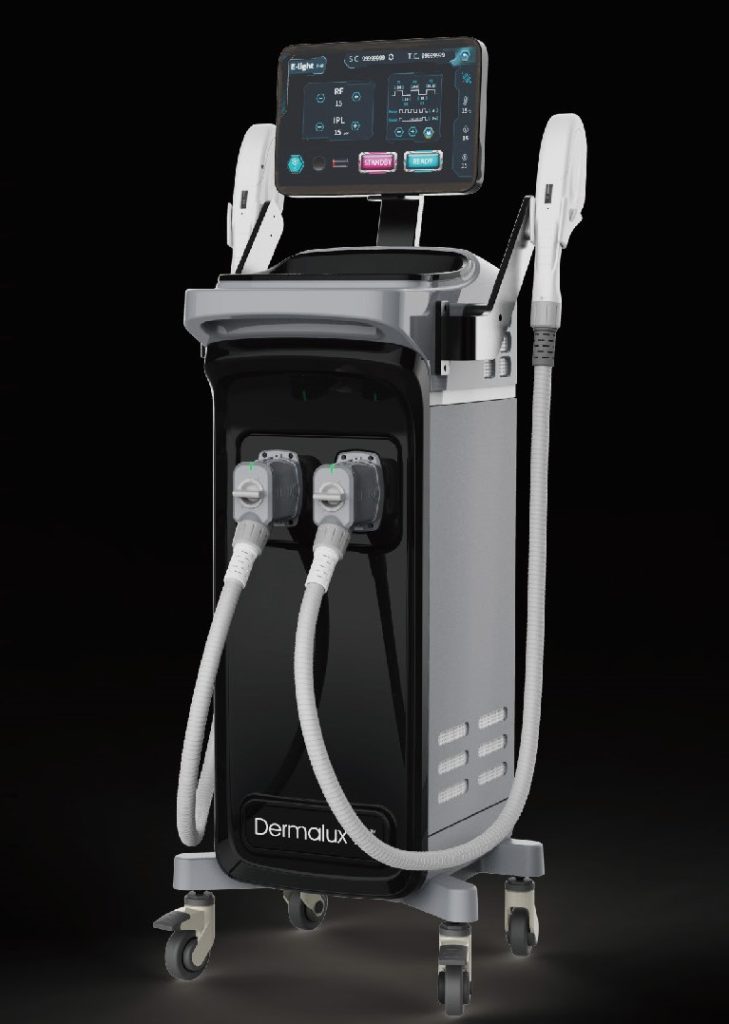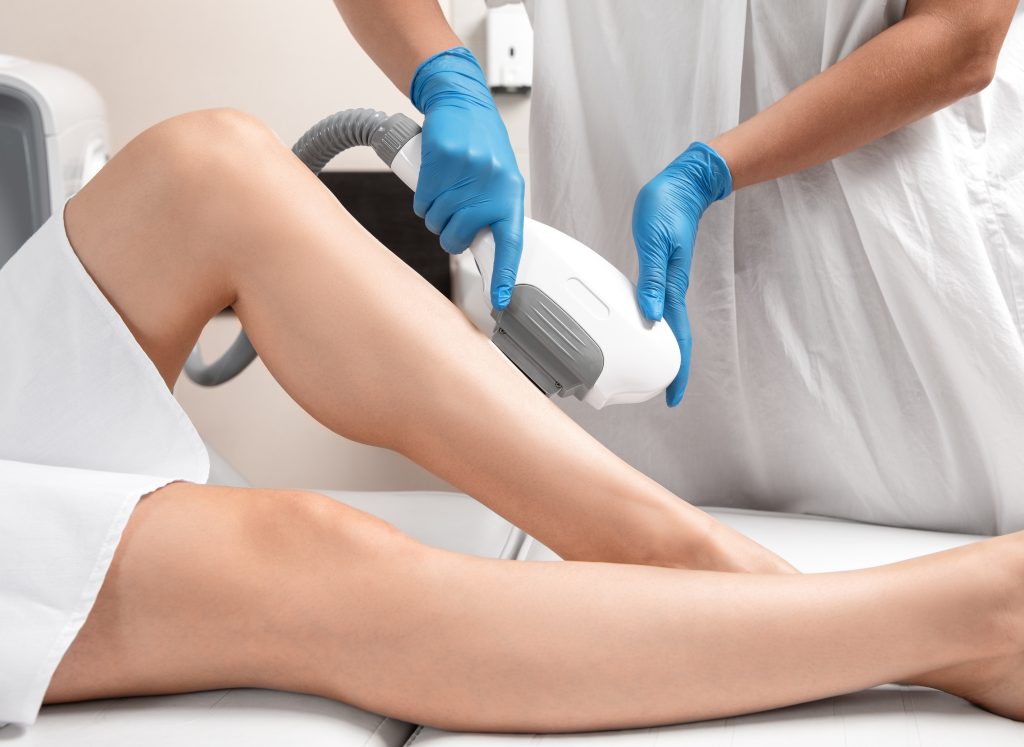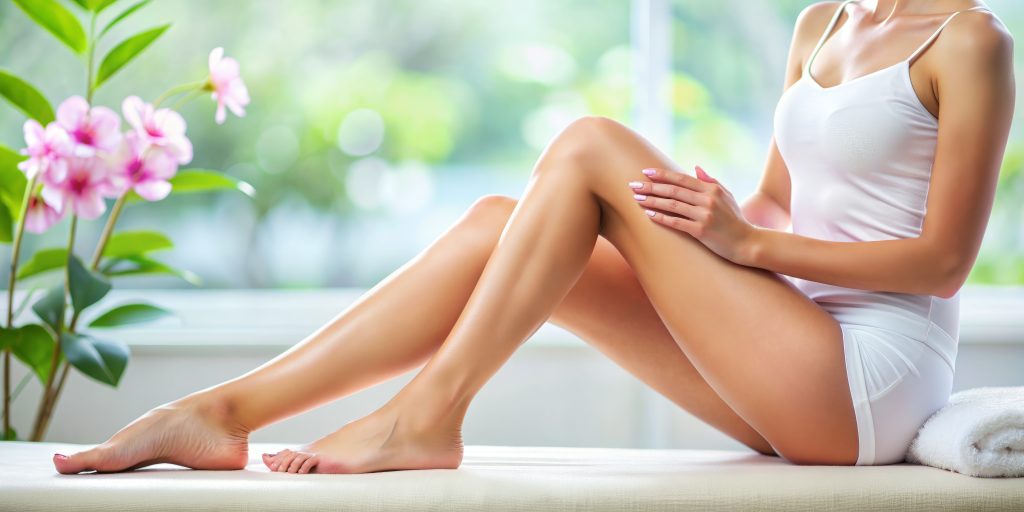Permanent hair removal
About E-Light treatment with the Dermalux II E-Light-SHR device
Yeti legs, stubble, nervous last-minute shaving before going to the swimming pool, sports, summer trip, etc…..BYE BYE!!!!

What is the E-Light method?
The E-Light method is a more modern version of the IPL (Intense Pulsed Light) method. A light pulse is emitted first, and then the radio frequency function is automatically switched on. It works as a permanent hair removal method for hairs that are currently in the growth phase, as well as for various aesthetic or medical conditions of the skin: pigment spots, freckles, aging skin, acne. The light is absorbed in the dark pigments of the hair and hair roots, and then it is thermally damaged by means of radio frequency.
The results and the length of therapy depend on the skin type, skin color, treated area, and other medical conditions. The number of treatments you need is individual. On average, it takes 6-12 treatments until the hair is permanently reduced by 80%-95%.
E-Light/SHR device Dermalux II
The most important areas of application for this device are SHR (Super Hair Removal) Flash-Light hair removal and facial rejuvenation. In the treatment head there is a high-performance xenon lamp that flashes only for a short time interval. A constantly cooled prism (3-5°C) directs the light to the skin. Thanks to the cooling, the skin is not heated up very much and so skin irritations can be minimized. In E-Light mode, a radio frequency signal is additionally emitted, which reaches to the hair follicle and is converted into heat there. This further increases the heat effect. It is ideal for lighter skin types.
The E-Light treatment can be used for skin rejuvenation, as it induces the multiplication of collagen and elastin in the skin, making the skin look younger and more elastic. Furthermore, this method is suitable for the treatment of pigment spots and certain skin inflammations (acne).
The emitted light is not a LASER! Its spectrum is partly in the visible range (SR: 530-950nm, HR: 640-950nm), which is excellently absorbed into the dye (melanin) of the hair. Different wavelengths are absorbed in different colored dyes, so that the device can be used effectively on all skin types. The hair conducts the light to the hair follicle, where it is absorbed and converted into heat, whereby the hair follicle suffers irreversible damage and can no longer produce hair. Existing hairs fall out and no new ones grow in their place.
The most important areas of application for this device are SHR (Super Hair Removal) Flash-Light hair removal and facial rejuvenation. In the treatment head there is a high-performance xenon lamp that flashes only for a short time interval. A constantly cooled prism (3-5°C) directs the light to the skin. Thanks to the cooling, the skin is not heated up very much and so skin irritations can be minimized. In E-Light mode, a radio frequency signal is additionally emitted, which reaches to the hair follicle and is converted into heat there. This further increases the heat effect. It is ideal for lighter skin types.
The E-Light treatment can be used for skin rejuvenation, as it induces the multiplication of collagen and elastin in the skin, making the skin look younger and more elastic. Furthermore, this method is suitable for the treatment of pigment spots and certain skin inflammations (acne).

The emitted light is not a LASER! Its spectrum is partly in the visible range (SR: 530-950nm, HR: 640-950nm), which is excellently absorbed into the dye (melanin) of the hair. Different wavelengths are absorbed in different colored dyes, so that the device can be used effectively on all skin types. The hair conducts the light to the hair follicle, where it is absorbed and converted into heat, whereby the hair follicle suffers irreversible damage and can no longer produce hair. Existing hairs fall out and no new ones grow in their place.

Preparation before E-Light/SHR hair removal:
- Shave the hair on the areas to be treated 1-3 days before the treatment! Ideally, the hairs should be about 1-2mm long
- No mechanical epilation, waxing, plucking etc. 4 weeks before the treatment, as it changes the growth cycle of the hair! During the entire treatment period, mechanical hair removal should be avoided, but shaving is allowed.
- Deodorant sprays, creams, perfumes should be avoided.
- Write down a list of medications taken in the last 10 days.
- 5. NO SUNBATHING OR SOLARIUM up to 2-3 weeks before the treatment!
How does the treatment work?
- Step 1: The moles are covered with a white waterproof pen.
- Step 2: The skin is cleaned with Octenisept solution
- Step 3: Both the person being treated and the specialist performing the treatment put on IPL glasses! The glasses must remain on until the device is switched off!!! Without these safety precautions, serious eye damage can occur.
- Step 4: An ultrasound gel is applied to improve the energy transfer between the device head and the skin
- Step 5: The device head is placed on the skin surface and a light pulse is released. You may feel a slight tingling or prickling on the skin. Thanks to the constantly cooled treatment head of the Dermolux II device, the area is cooled parallel to the treatment, further reducing the possibility of skin damage.
- Step 6: A soothing lotion is then applied to the skin
After the treatment
- No intense sun exposure or solarium visits for 14 days! Apply sunscreen! Not only is UV radiation a problem for freshly treated skin, but also infrared radiation!
- Do not epilate, wax or pluck hair during the entire hair removal treatment. Only shaving is allowed.
- Apply soothing skin care if necessary. We are happy to advise you.

How long does the treatment take?
Treatment duration: approx. 15-30 minutes.
What is the difference between IPL and E-Light technology?
The combination of IPL and radio frequency enables more efficient but more pleasant hair removal/treatment.
What does an average treatment plan look like?
As a rule, approx. 1/4 – 1/3 of the hairs are in the growth phase. The E-Light treatment reaches these, while the resting hair roots remain unaffected. Therefore, the treatments are repeated 4-6x every 4-5 weeks. (Results vary depending on skin type/hair type) until a hair growth cycle is missed between 2 treatments. Then we take a 3-month break. From then on, the hair roots are treated 2-4x every 3 months. After that, maintenance treatments are sometimes, if at all, necessary 1x annually 1 or 2x more.
Contraindications
- Sun- or solarium-tanned skin
- Treatment with topically (locally) used medications (antibiotic or steroid cream, etc.)
- Treatment with systemic steroids (cortisone tablets, etc.)
- Treatment with anticoagulants (blood-thinning medications)
- Treatment with photosensitizing agents
The Photosensitizing Drugs Include:
- Antidepressiva (Amitriptylin, Clomiramin, Desipramin, Doxepin, Imipramin, Nortriptylin, Trimipramin)
- Antiepileptika (Carbamazepin, Lamotrigin, Phenobarbital, Phenytoin, Topiramat, Valproinsäure)
- Antihistaminika (Cyproheptadin, Diphehydramin, Loratadin)
- Antimikrobielle Substanzen (Ciprofloxacin, Doxycyclin, Enoxacin, Gentamycin, Griseofulvin, Isoniazid, Lomefloxacin, Minocyclin, Nitrofurantoin, Norfloxacin, Ofloxacin, Oxytetracyclin, Sulfamethoxazol/Trimethoprim, Sulfasalazin)
- Antipsychotika (Chlorpromazin, Chlorprothixen, Fluphenazin, Haloperidol, Perazin, Promethazin, Promazin, Thioridazin)
- Diuretika (Amilorid, Bendroflumethiazid, Etycrynsäure, Furosemid, Hydrochlorothiazid, Spironolacton, Triamteren, Xipamid)
- Goldsalze
- Hämatoporphyrin
- Hormone (Corticosteroide, Östrogene, Progesterone, Spironolacton)
- Kardiovaskulär wirksame Substanzen (Amiodaron, Captopril, Chinidin, Disopyramid, Enalapril, Fosinopril, Hydralazin, Nifedipin, Ramipril, Simvastatin)
- Nichtsteroidale Antirheumatika (Diclofenac, Ibuprofen, Indometacin, Ketoprofen, Mefenaminsäure, Naproxen, Phenylbutazon, Tiaprofensäure)
- Protonenpumpenhemmer (Esomeprazol, Lansoprazol, Omeprazol, Pantoprazol, Rabeprazol)
- Substanzen gegen Malaria (Chinin, Chloroquin, Hydroxychloroquin, Mefloquin, Pyrimethamin)
- Systemische Dermatika (Isotretinoin, Methoxsalen)
- Zytotoxische Substanzen (Azathioprin, Dacarbazin, Fluorouracil, Methotrexat, Procarbazin, Vinblastin)
- Fever
- Pregnancy
- Pacemaker
- Long-term diabetes
- Hemophilia, coagulation disorders
- Genetic or acquired diseases with photosensitization
- Malignant melanomas
- Skin carcinomas
- Metal prostheses
- Herpes (fever blisters)
- Fever, infections
- Tattoos, permanent make-up cannot be treated due to the high pigment concentration, as the absorbed heat can lead to burns
Are there any side effects?
The skin is usually a little red after the treatment. However, these skin reactions disappear a few hours or days after the treatment.
Is the E-Light treatment painful?
No, in contrast to LASER or IPL devices, the treatment is practically painless. You may feel a slight prickling sensation, the skin is continuously cooled by the Dermalux II device.
